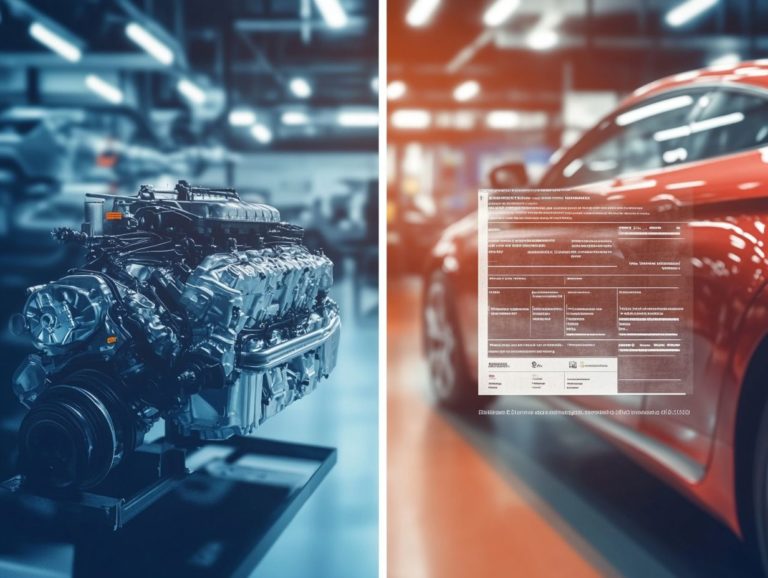The Process of Transferring a Car Warranty
Navigating car warranties can be a bit of a maze, particularly when it comes to transferring them. Whether you’re selling your vehicle, gifting it to someone, or relocating, understanding your warranty is essential.
This guide explains the different types of car warranties. It clarifies what makes a warranty transferable or non-transferable and outlines the steps you need to take for a seamless transfer process. Important considerations will also be highlighted, empowering you to make informed decisions at every turn.
Contents
Key Takeaways:

- A car warranty can be transferable or non-transferable, depending on the type.
- Transferring a car warranty may be necessary when selling or gifting a car, or when moving to a new state.
- Research the warranty provider’s policies, gather necessary documents, and notify the provider to successfully transfer a car warranty.
Understanding Car Warranties
Understanding car warranties is essential for every car owner. It offers valuable insights into coverage options, warranty terms, and the associated processes, all of which can profoundly influence your vehicle’s resale value.
By thoroughly understanding these details, you can confidently navigate factory warranties, transferable warranties, and the advantages linked to certified pre-owned vehicles. This ensures you fully leverage your warranty coverage and obligations.
Understanding how these warranties work helps you make better choices during the vehicle purchasing process and helps you select the right warranty providers.
Types of Car Warranties
There are several types of car warranties available, each designed to meet different needs and circumstances. You might encounter factory warranties, dealer warranties, extended warranties, third-party warranties, powertrain warranties, and bumper-to-bumper warranties.
Understanding the distinctions among these options can be crucial for you as a car owner. A factory warranty typically accompanies new vehicles, covering manufacturer defects for a specific duration or mileage perfect for the peace of mind you deserve.
Conversely, a dealer warranty might offer limited coverage and is often tied to services provided by a specific dealership.
Extended warranties serve as a safety net after the factory warranty expires, providing extra protection for various components. Third-party warranties offer flexibility, catering to both new and used vehicles, but they can vary widely in terms of coverage and reliability.
Meanwhile, a powertrain warranty covers the engine and transmission, while a bumper-to-bumper warranty covers nearly every aspect of the vehicle, delivering the most comprehensive protection.
Each of these options serves a unique purpose and can significantly shape your ownership experience. Evaluate your needs carefully to ensure you choose the right warranty.
What is Transferable and Non-Transferable
Understanding the distinction between transferable and non-transferable warranties is essential for you as both a seller and a buyer, as it significantly influences how warranty claims can be processed and the coverage options available to the new owner.
When a warranty is transferable, it allows you to inherit the original owner’s benefits. This makes it a compelling selling point that can enhance the property’s attractiveness. This type of warranty typically comes with fewer restrictions and may involve minimal or even no fees to activate the transfer.
On the other hand, non-transferable warranties confine coverage strictly to the original purchaser. This means that any subsequent owners won’t benefit from the warranty s protections or services, potentially leading to extra costs for repairs or replacements.
Review the warranty s eligibility criteria to avoid surprises regarding the implications this may have on your purchase.
Reasons for Transferring a Car Warranty
Transferring a car warranty can prove advantageous in numerous situations, such as when you sell or gift your vehicle to a new owner. This keeps the warranty coverage active, potentially elevating the vehicle’s resale value and providing peace of mind to the new owner.
Selling or Gifting a Car

When you sell or gift a car, transferring the warranty to the new owner is vital. This step ensures they receive essential coverage, protecting them from defects and maintenance costs.
This process provides peace of mind for the new owner and adds value to the transaction. Gather documentation like original warranty paperwork and proof of ownership to start the transfer.
By successfully completing this transfer, you demonstrate a commitment to customer satisfaction and build trust. This makes for a smoother transition. The new owner gains significantly, enjoying immediate access to the warranty protection, simplifying repairs, and boosting their confidence in the purchase.
Moving to a Different State
Relocating to a different state may require you to transfer your warranty. Warranty policies can differ by region, affecting your access to benefits and services.
The complexity arises from the fact that not all manufacturers standardize their warranty terms nationwide. Some states have specific regulations regarding coverage, duration, and the claims process.
Be aware of these nuances, as you might face challenges in validating your warranty after moving. Regional policies can affect aspects like repair shop affiliations, dictating where and how repairs can be conducted under warranty.
Protect your warranty after the move! Do thorough research to ensure it remains valid and hassle-free.
Steps to Transfer a Car Warranty
Transferring a car warranty involves essential steps for a seamless process. Begin by researching the warranty provider’s policies and understanding the claims process for car warranties to understand their requirements.
Next, gather all necessary documentation, including proof of ownership and the VIN, which is a unique code for your vehicle. Finally, notify the warranty provider to facilitate a smooth transition, ensuring that all aspects of the transfer are properly addressed.
Researching the Warranty Provider’s Policies
Start by researching your warranty provider’s policies. These policies detail the terms for warranty transfer, coverage options, and any fees.
To ensure a seamless transition, carefully examine these policies and understand what is required for a successful transfer. Key factors include the timeline for the transfer, necessary documentation, and any eligibility criteria for the new owner.
Being aware of any limitations or exclusions that could impact the coverage after the transfer is beneficial. By taking these steps, you can navigate the complexities of changing ownership while ensuring your vehicle remains protected under the warranty.
Gathering Necessary Documents
Gathering necessary documents is crucial for the warranty transfer. Obtain proof of ownership and the VIN, which is essential for verification and claims.
Having a copy of the original warranty agreement is invaluable. This agreement outlines the terms and conditions associated with the warranty, ensuring the new owner is informed about the coverage specifics.
Having a copy of the maintenance records is also important. These documents show that the vehicle has been well cared for, adhering to the recommended service intervals.
This not only helps retain warranty coverage but also provides the new owner with insight into the vehicle’s history, which can be vital for future repairs or claims.
Notifying the Warranty Provider

Notifying the warranty provider about the transfer is crucial to completing the process, allowing you, as the new owner, to enjoy uninterrupted access to warranty claims and benefits.
This step ensures that the warranty provider updates their records, smoothing the transition for you. Start by locating the warranty documents; they often contain the necessary contact information for the provider.
It s wise to reach out using the preferred method outlined in those documents, whether it s a phone call or an email. Clearly communicate the transfer, providing all required details like the original owner’s information, your name as the new owner, and the relevant product information.
This clarity not only expedites the process but also ensures you maintain valuable protection as the new owner.
Considerations Before Transferring a Car Warranty
Before transferring a car warranty, keep these important tips in mind! You should fully understand the costs and fees associated with the transfer, as well as any exceptions or limitations that may apply to the warranty.
It’s essential to assess if the new owner is eligible for the warranty coverage. This careful evaluation will ensure a smooth and seamless transition.
Costs and Fees
Understanding the costs and fees associated with transferring a car warranty is crucial. These expenses can vary widely based on the warranty policies and coverage options offered by the provider.
Several factors play a role in these costs, including administrative fees, charges that depend on how long you’ve had the warranty, and even potential penalties for canceling an existing warranty. It s also important to keep in mind that some providers may impose additional fees for the transfer process itself, which can significantly impact your final decision.
By grasping these financial implications, you can better assess whether it s more advantageous to proceed with the warranty transfer or to explore alternative coverage options. This understanding empowers you to make an informed choice. Ensure your newly qualified vehicle receives the protection it deserves while avoiding unexpected costs.
Potential Limitations or Exclusions
Be aware that there may be potential limitations or exclusions tied to car warranties that could impact the transfer process, including warranty exceptions that differ by provider.
These limitations often encompass specific components that aren’t covered, such as parts that naturally wear out over time or any modifications made post-purchase, which can become crucial when it comes time to transfer ownership. Some warranties might also impose additional fees or require certain conditions to be met for the transfer to take place.
By understanding these nuances, you can navigate the complexities of warranty coverage and ensure that potential buyers are well-informed about what is and isn t included.
This clarity not only streamlines the transfer process but also helps preserve the vehicle s value in the eyes of prospective owners.
Frequently Asked Questions
What is the process for transferring a car warranty?

The process for transferring a car warranty involves several steps. First, you will need to gather all necessary documents, including the warranty contract, bill of sale, and transfer paperwork from the warranty company. Next, you will need to contact the warranty company to inform them of the transfer and provide them with the necessary information. Finally, the new owner will need to sign the transfer paperwork and pay any applicable fees.
Why do I need to transfer my car warranty?
Transferring a car warranty is important because it ensures that the warranty coverage will continue with the new owner after you sell the car. If the warranty is not transferred, the new owner will not be able to make any claims under the warranty in the event of a covered repair.
Can I transfer my car warranty at any time?
Transfer your car warranty as soon as you sell your vehicle. Most companies require the transfer to happen within 30 to 90 days.
If you delay, you may incur extra fees, or the transfer might not be allowed.
What happens if I don’t transfer my car warranty?
If you skip the transfer, the warranty coverage ends with the sale.
The new owner won’t be able to claim repairs under the warranty, even if it’s still valid.
Is there a fee for transferring a car warranty?
Transfer fees differ by warranty company. Some charge a flat fee, while others may take a percentage of the warranty’s value.
Always check with your warranty provider for their specific fees.
Can I transfer my car warranty if I still owe money on the car?
Yes, you can usually transfer your warranty even if you have an outstanding loan.
Just make sure to get approval from your lender before proceeding. Confirm the specific requirements with both your warranty company and lender.




